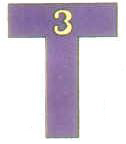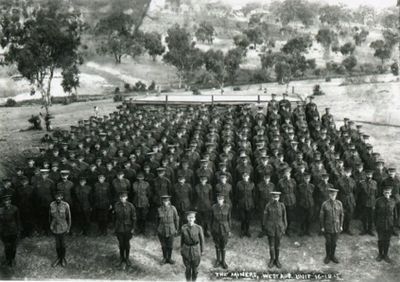3rd Tunnelling Company
From Our Contribution
 | |
 WA Tunnellers just prior to travelling to Sydney | |
Brief History
The Australian Mining Corps was raised within the A.I.F. around August/September 1915. It is known that the manning of that unit specifically included a proportion of members from the mining industry and allowed enlistment up to the age of 50 to capture the experienced men the Corps would need to fulfil its role. About 38% of the men had been employed within the mining industry.
The original No 3 Company consisted of Company Headquarters and three sections recruited in Western Australia. No 3 Company had a strength of 1 Officer and 274 Other Ranks, embarking from Fremantle on 18 Dec 1915 for Sydney aboard SS Indarra.
On Boxing Day (Dec 26th), 1915 the Unit arrived in Sydney and marched into Casula Camp, near Liverpool, NSW. They were joined by the 4th Section of the Tasmanian Miners, bringing the establishment strength up to 15 officers and 349 Other Ranks under the command of 2nd Lieutenant L.J. Coulter. Mining Corps Units from all Military districts came together at Casula to complete training as a Corps.
At a civic parade in the Domain, Sydney on Saturday February 19, 1916, a large crowd of relations and friends of the departing Miners lined the four sides of the parade ground. Sixty police and 100 Garrison Military Police were on hand to keep the crowds within bounds.
1,248 members of the Corps who boarded HMAT A38 Ulysses in Sydney, NSW on February 20 and sailed for the European theatre. Arriving in Melbourne, Victoria on February 22 the Miners camped at Broadmeadows for a stay of 7 days while further cargo was loaded.
Another parade was held at the Broadmeadows camp on March 1, the Miners’ Corps being inspected by the Governor-General, as Commander-in-Chief of the Commonwealth military forces.
Leaving Melbourne on March 1, Ulysses arrived at Fremantle, Western Australia on March 7 where a further 53 members were taken on board.
On Wednesday March 8, 1916 the whole force, with their band and equipment, paraded at Fremantle prior to leaving Victoria Quay at 9.30 o’clock.
The ship hit a reef when leaving Fremantle harbour, stripping the plates for 40 feet and, although there was a gap in the outside plate, the inner bilge plates were not punctured. The men on board nicknamed her ‘Useless’. The Miners were off-loaded and sent to the Blackboy Hill Camp where further training was conducted.
Finally departing Fremantle on April 1, Ulysses voyaged via Suez, Port Said and Alexandria in Egypt. The Captain of the ship was reluctant to take Ulysses out of the Suez Canal because he felt the weight of the ship made it impossible to manoeuvre in the situation of a submarine attack. The troops were transhipped to HM Transport B.1 Ansonia, then on to Valetta, Malta before disembarking at Marseilles, France on May 5, 1916. As a unit they entrained at Marseilles on May 7 and detrained on May 11 at Hazebrouck.
Soon after arrival, the Australian Mining Corps ceased to exist as a whole and was redesignated into three Tunnelling Companies. After a fairly short training period with British and Canadian Tunnelling Companies already in France, the Australian Companies were allotted to different Armies and assigned separate areas of responsibility. Their tasks were allocated by the General Officer Commanding the British Expeditionary Force through the Controller of Mines.
Primary tasks of the Tunnelling Companies were the construction of tunnels and mines for offensive action against the enemy, detection and interruption of the enemy’s counter-mining efforts, and the construction of underground dugouts to accommodate large groups of men, in many cases whole battalions of 1,000 men including Battalion Headquarters.
3rd Australian Tunnelling Company went to the Fauquissart area and took over chalk workings at Hill 70.
Unit Personnel
- Lyndon Vivian Brady 30 Sep 1916 - 21 Dec 1918
- Reginald Samuel Roquerbre Dutton 31 Jan 1917 - 30 Mar 1919
- Arthur Charles Grafham 15 Jun 1917 - 27 Apr 1919
- William George Munday ?? Nov 1915 - 27 Mar 1919
- Thomas William Wheatley 15 Jun 1917 - 16 Oct 1918
Individual Honours
- 2 Distinguished Service Orders
- 12 Military Crosses, and one bar
- 4 Distinguished Conduct Medals
- 22 Military Medals
- 4 Meritorious Service Medals
- 11 Mentioned in Despatches
Notes
Content for the history and honours sections has come from a combination of Wikipedia and the Australian War Memorial websites.
For further detail on the Tunnelling units during ww1, see:
- Crumos and Camouflets - Australian Tunnelling Companies on the Western Front by D Findlayson